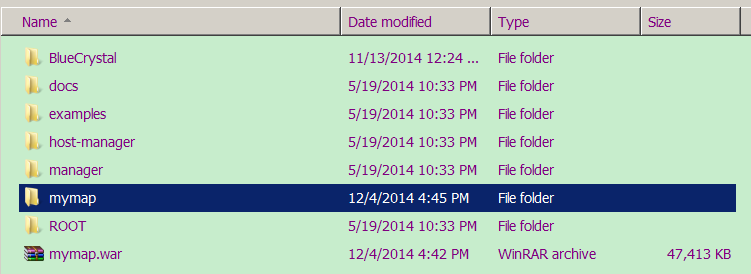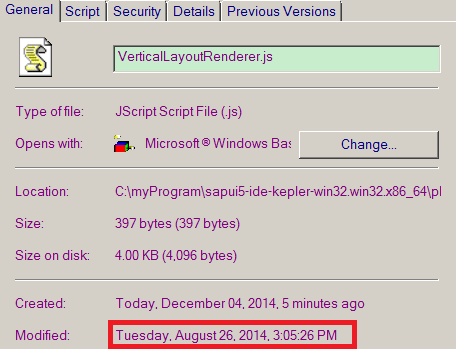
- SAP Community
- Products and Technology
- Technology
- Technology Blogs by SAP
- Explore the com.sap.ui5.resource.ResourceServlet
- Subscribe to RSS Feed
- Mark as New
- Mark as Read
- Bookmark
- Subscribe
- Printer Friendly Page
- Report Inappropriate Content
In my sample project mymap, there is no folder named resources and thus no sap-ui-core.js either.

However, in the runtime, you could indeed observe the folder resources and the sap-ui-core.js inside it via Chrome development tool, tab "Sources":

In order to figure out what happens in the runtime, let's have a look at the web.xml under folder WEB-INF in the project.
There is a ResourceServlet defined. Actually it is the responsibility of this servlet delivered by SAP, which returns the content of resources like js, css and other type in the runtime. So now if I would like to investigate on this servlet, how could I get its source code?

How to get source code of ResourceServlet
Suppose you have already an working Tomcat instance. Right click your UI5 project, choose Export->War file, and manually copy that exported war file to the webapps folder of your tomcat instance folder. In my case the folder is : C:\myProgram\tomcat-7.0.54\webapps.
Now start your tomcat via bat file, in my case: "C:\myProgram\tomcat-7.0.54\bin\startup.bat":
You should see one information message that the war file is deployed:

Now go back to your webapps folder, you should have a folder mymap which is automatically unzipped from war file by Tomcat.

Now just search by keyword "Resource", and unzip the first hit jar file.

After that you could find three .class file in the unzipped folder, in my case they are:
- "C:\myProgram\tomcat-7.0.54\webapps\mymap\WEB-INF\lib\com.sap.ui5.resource_1.24.1\com\sap\ui5\resource\ResourceServlet.class"
- "C:\myProgram\tomcat-7.0.54\webapps\mymap\WEB-INF\lib\com.sap.ui5.resource_1.24.1\com\sap\ui5\resource\impl\ServletResource.class"
- "C:\myProgram\tomcat-7.0.54\webapps\mymap\WEB-INF\lib\com.sap.ui5.resource_1.24.1\com\sap\ui5\resource\impl\ServletResourceLocator.class"
The last step, google "jd-gui" and download it. It allows you to directly review source code of a .class file.


Since now we have source code at hand, we could do further investigation on this servlet.
More investigation on ResourceServlet
The main job of resource handling is wrapped in method serveResource of class ResourceServlet. We could find at least 2 useful hint from this method.
1. use dev mode to figure out where the resource is loaded

From line 616 and 617, we get to know if the current application runs under Dev mode, it is supported to print out the url of the found resource in http response header.
Just switch on Dev mode by making following settings in web.xml:

after that you could observe the x-sap-ResourceUrl attribute for sap-ui-core.js in Chrome Network tab, which shows where Tomcat loads this js file in the runtime.

You could directly browse your application resource by appending "/resources/" to your application url, in my case it is: http://localhost:8080/mymap/resources/

You might already notice the "CLASSPATH", what does it mean?
The constructor of ServletResource which extends base class Resource has one parameter source, which indicates whether this resource is loaded locally or remotely ( configured through parameter com.sap.ui5.resource.REMOTE_LOCATION 😞

in class ServletResourceLocator which implements interface ResourceLocator, the instance for found ServletResource is initialized with corresponding source category, "CLASSPATH" or "REMOTE", according to different approaches how they are actually loaded:

And ResourceServlet will print out this property for each found resource between a pair of "[ ]":

this is the reason why you could see lots of CLASSPATH in tomcat output:

2. understand HTTP 304 status
For example, why I get a HTTP 304 Not Modified for this file?

The answer is in line 625 of ResourceServlet class:

In this example, the second condition after && is always true, since I never make any modifications on this standard library js file:

So we only need to evaluate the result of CacheControlFilter.hasNoCacheHeader(request). The source code of this method is listed below:

In my example since there is no such Cache-Control in request header, this method will return false and finally leads to a 304 status code.

So now if we click the checkbox "Disable cache" in Chrome, we then get a HTTP 200 status code instead, since this checkbox adds a Cache-Control header with value "no-cache":

With the approach introduced in this blog, you could also explore another servlet by yourself, which you could also find and configure it in web.xml: com.sap.ui5.proxy.SimpleProxyServlet.
Enjoy learning 🙂
- SAP Managed Tags:
- SAPUI5,
- SAP Enterprise Portal
You must be a registered user to add a comment. If you've already registered, sign in. Otherwise, register and sign in.
-
ABAP CDS Views - CDC (Change Data Capture)
2 -
AI
1 -
Analyze Workload Data
1 -
BTP
1 -
Business and IT Integration
2 -
Business application stu
1 -
Business Technology Platform
1 -
Business Trends
1,658 -
Business Trends
93 -
CAP
1 -
cf
1 -
Cloud Foundry
1 -
Confluent
1 -
Customer COE Basics and Fundamentals
1 -
Customer COE Latest and Greatest
3 -
Customer Data Browser app
1 -
Data Analysis Tool
1 -
data migration
1 -
data transfer
1 -
Datasphere
2 -
Event Information
1,400 -
Event Information
66 -
Expert
1 -
Expert Insights
177 -
Expert Insights
299 -
General
1 -
Google cloud
1 -
Google Next'24
1 -
Kafka
1 -
Life at SAP
780 -
Life at SAP
13 -
Migrate your Data App
1 -
MTA
1 -
Network Performance Analysis
1 -
NodeJS
1 -
PDF
1 -
POC
1 -
Product Updates
4,577 -
Product Updates
345 -
Replication Flow
1 -
RisewithSAP
1 -
SAP BTP
1 -
SAP BTP Cloud Foundry
1 -
SAP Cloud ALM
1 -
SAP Cloud Application Programming Model
1 -
SAP Datasphere
2 -
SAP S4HANA Cloud
1 -
SAP S4HANA Migration Cockpit
1 -
Technology Updates
6,873 -
Technology Updates
425 -
Workload Fluctuations
1
- SAP Build Process Automation Pre-built content for Finance Use cases in Technology Blogs by SAP
- Start page of SAP Signavio Process Insights, discovery edition, the 4 pillars and documentation in Technology Blogs by SAP
- Support for API Business Hub Enterprise in Actions Project in Technology Blogs by SAP
- Composite Data Source Configuration in Optimized Story Experience in Technology Blogs by SAP
- Exploring Integration Options in SAP Datasphere with the focus on using SAP extractors - Part II in Technology Blogs by SAP
| User | Count |
|---|---|
| 40 | |
| 25 | |
| 17 | |
| 14 | |
| 8 | |
| 7 | |
| 7 | |
| 7 | |
| 6 | |
| 6 |